Slicing meat when making making beef jerky is where you get to decide whether you want a chewy jerky or a more tender jerky. Here you will learn the different ways of slicing meat so you can get the best feel and taste out of your beef jerky!
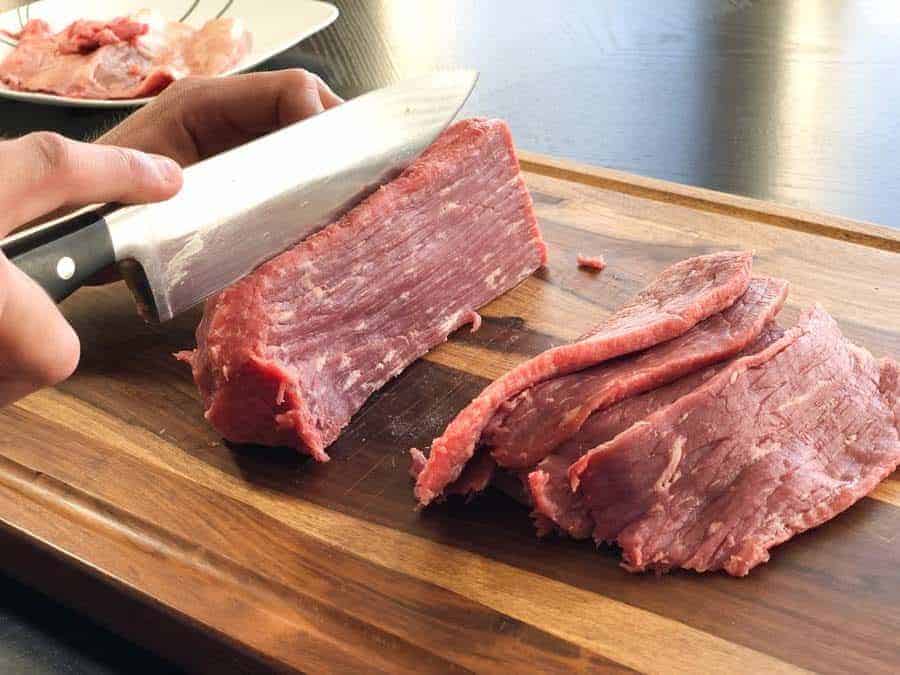
So hopefully at this point you have decided what type of meat to use when making your homemade beef jerky, now you just need to trim and slice it! If you haven't picked a cut of beef yet, visit my page on Best Cuts of Beef for Jerky.
These instructions are the same if you are slicing venison for venison jerky as well. So get the deer roast ready and let's get started!
Jump to:
🎥 Video - Slicing meat
🥩 Trim the fat
First, trim any visible fat from your cut of meat. Here is a lean Beef Eye of Round Roast before trimmed.
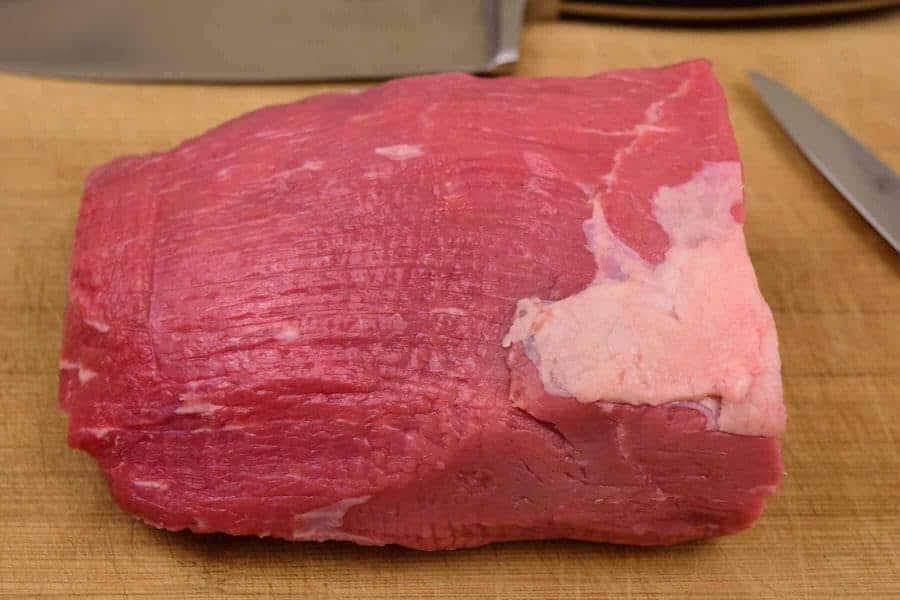
Use a sharp knife to cut away any fat. Fat makes beef jerky spoil faster, so it is best to trim as much as you can now to prevent your jerky from going bad.
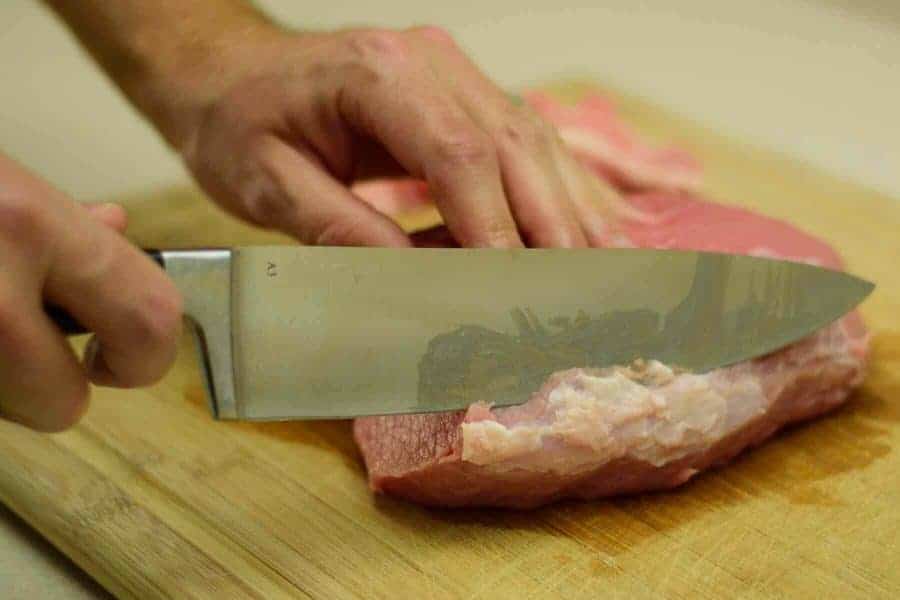
🔪 Cut with or against the grain?
You have probably heard about the "grain" of meat; and depending on how you cut in regards to the grain will affect the texture of your jerky. The simplest explanation is:
- Slicing WITH the grain = Chewy / Tough Jerky
- Slicing AGAINST the grain = Less Chewy / Soft Jerky
So what exactly is the "grain" of meat? The grain of meat refers to the direction the muscle fibers run within a piece of meat. Okay, so how do you know what direction the muscle fibers run?
You will be able to see the lines of fibers that run parallel to each other along a cut of meat. In the picture below, the fibers are running vertically from bottom to top.
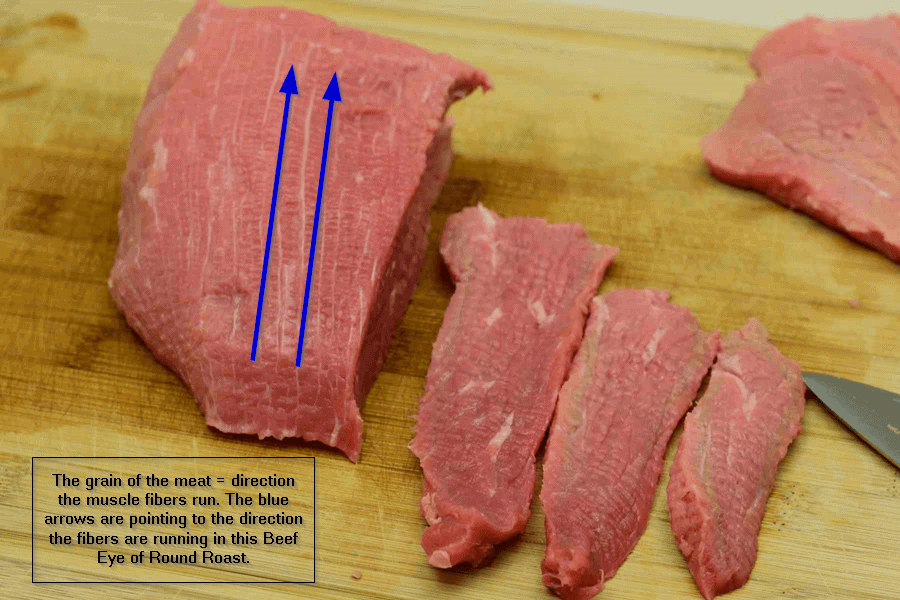
Slicing in the SAME direction of the fibers is called "slicing WITH the grain". The 3 slices of meat seen above were sliced WITH the grain at about a ¼" thick. As mentioned earlier, slicing with the grain will produce a more chewy / tougher piece of jerky.
In the picture below you will see the blue arrows again showing the direction of the grain of the meat. When slicing the meat perpendicular to the direction of the grain (in the direction of the black arrows), you will be slicing AGAINST the grain. Again, as mentioned earlier; this will produce a softer / less chewy piece of jerky.
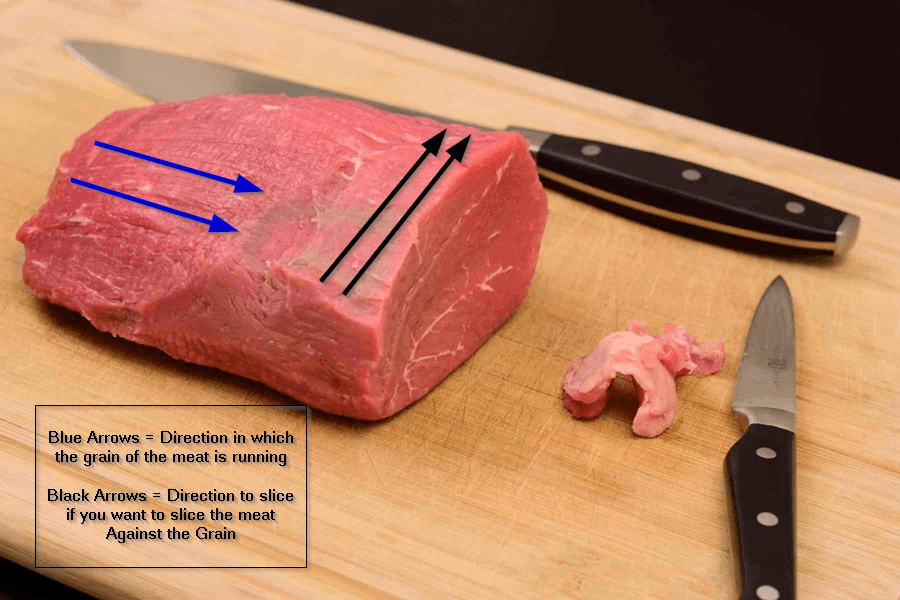
Below is an example of slicing AGAINST the grain.
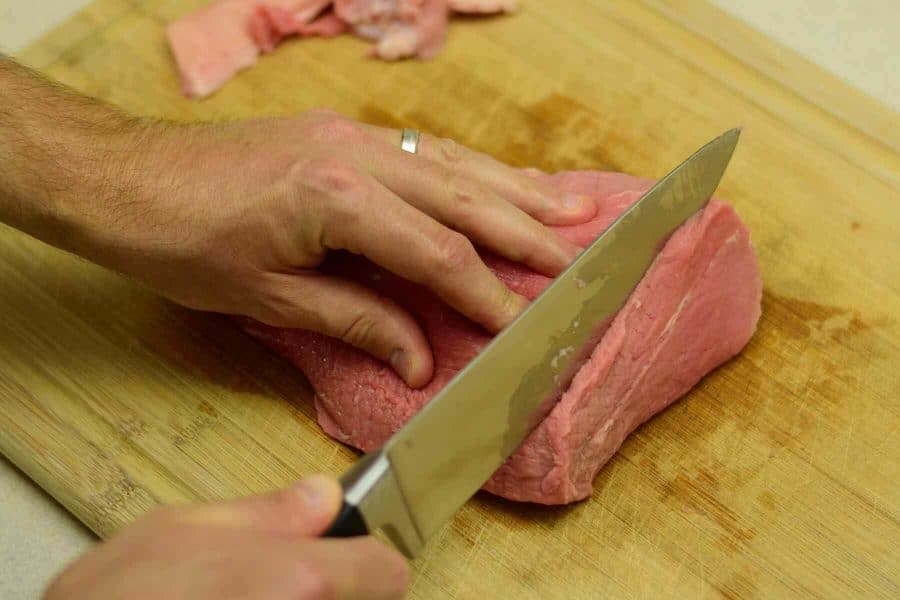
This is what a slice of meat looks like when it is cut against the grain at about ¼" thick. You can see that the muscle fibers are running in several directions. This makes the jerky easier to tear apart and less tough.
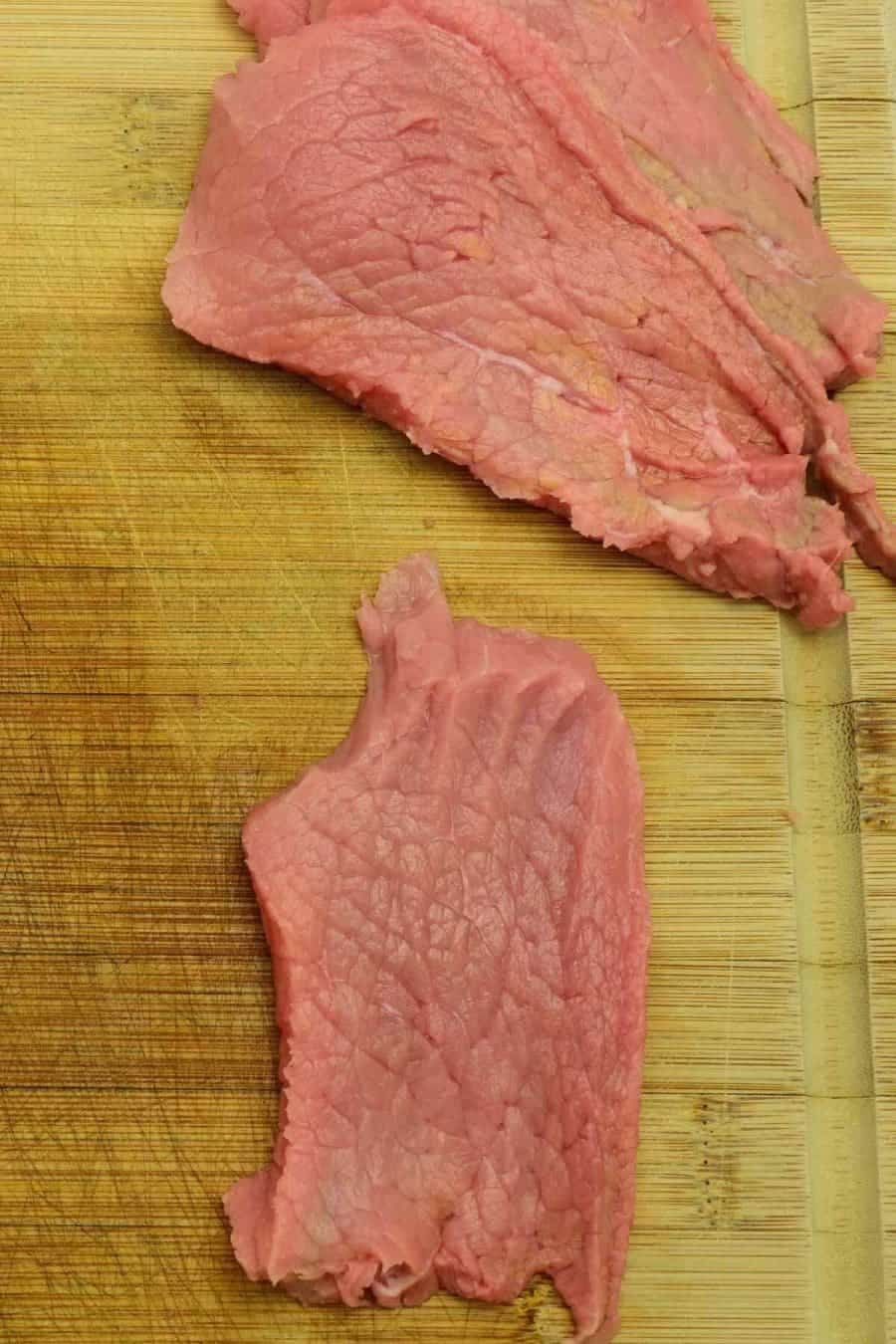
This post may have affiliate links, visit our privacy policy for more information
Jerky slicer
You can also use a jerky slicer when cutting up beef jerky meat. I use a Westin Jerky Slicer to get even sized strips which is fantastic when drying your jerky. Since the strips are the exact same size, they dry evenly.
This means no more pulling several pieces of jerky off the dehydrator and leaving other pieces on to keep drying because they are a little thicker.
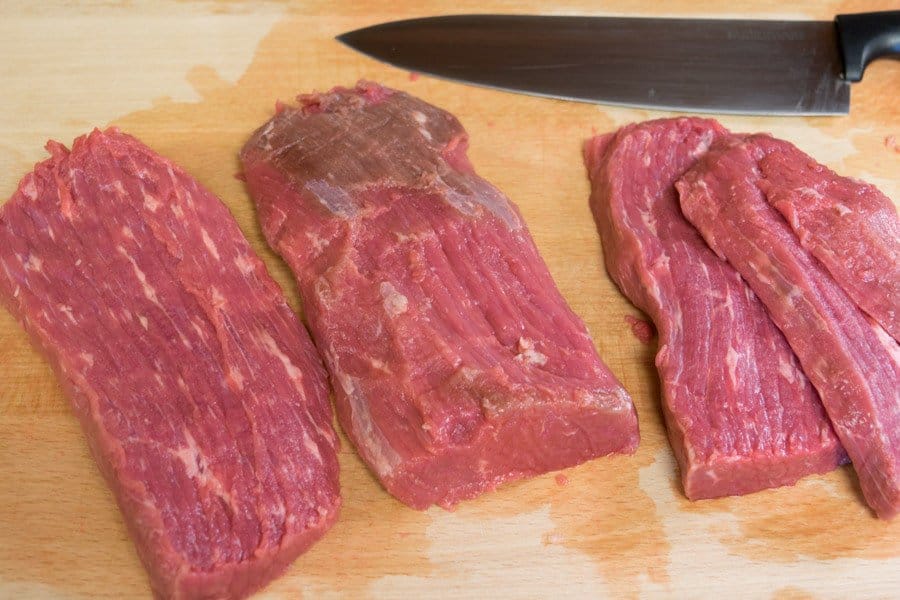
To use the Westin Slicer, cut the roast in 1 ¼" slabs and feed it through the machine. A couple turns of the handle feeds the piece of meat through and it slices it with ease.
Just feed the slabs through the slicer either with the grain or against the grain to achieve your favorite chew!
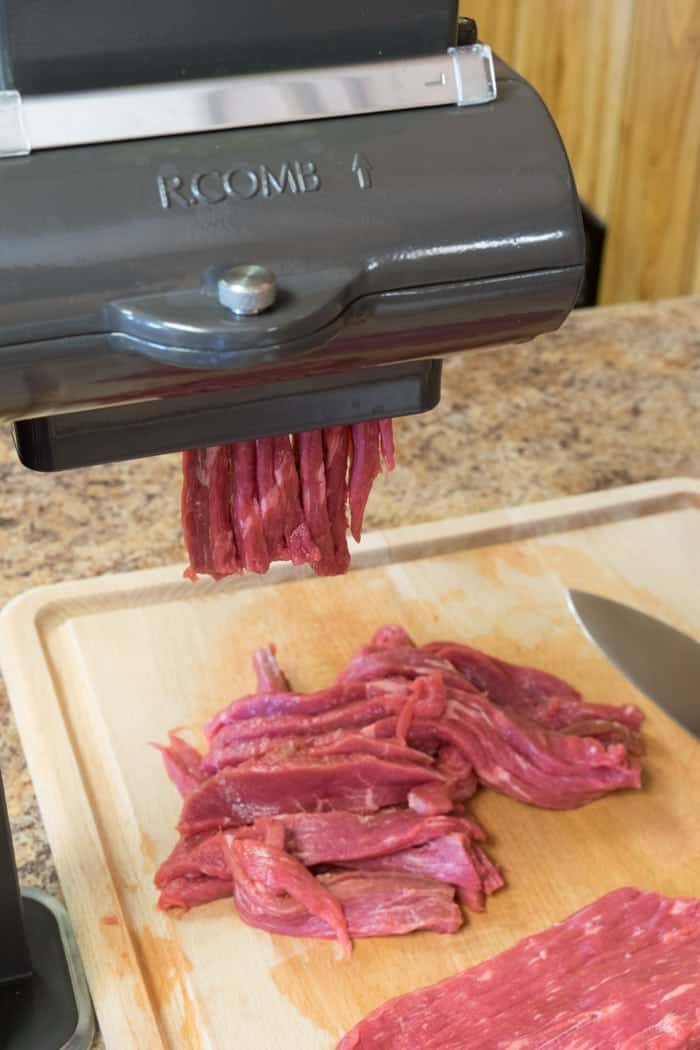
Tenderizing
Slice the meat WITH the grain and tenderize with a meat mallet (beat the hell out of it with the pyramid pointed side). This will break up the muscle fibers and make the jerky a little less chewy. (This will give you a chew not as tough as if you sliced only with the grain and not as soft as slicing only against the grain)
This technique works great when making The BEST Beef Jerky Recipe.
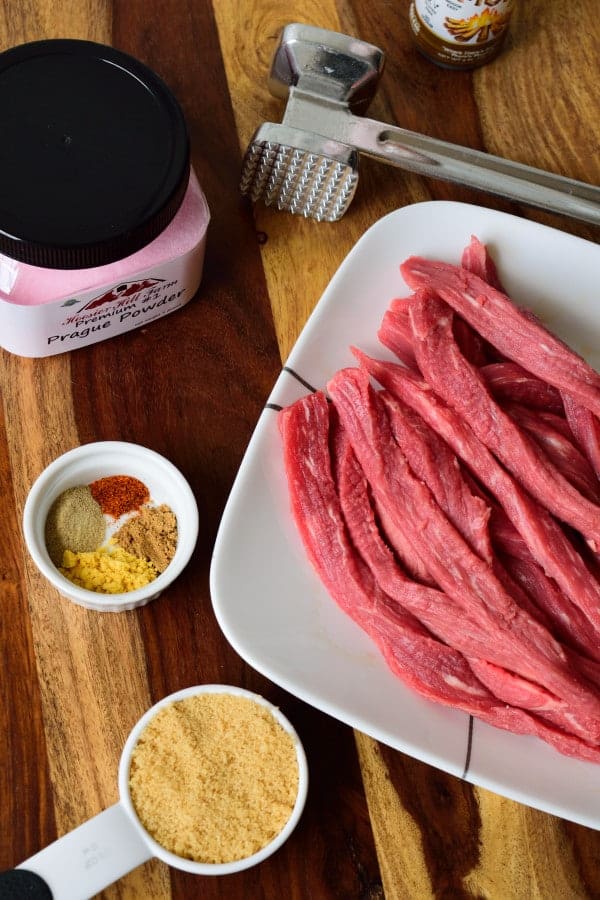
I hope this has helped you decide how to slice your beef for making beef jerky. Let me know if you have any questions in the comment section below! Happy Jerky Making!!!
Related Posts:
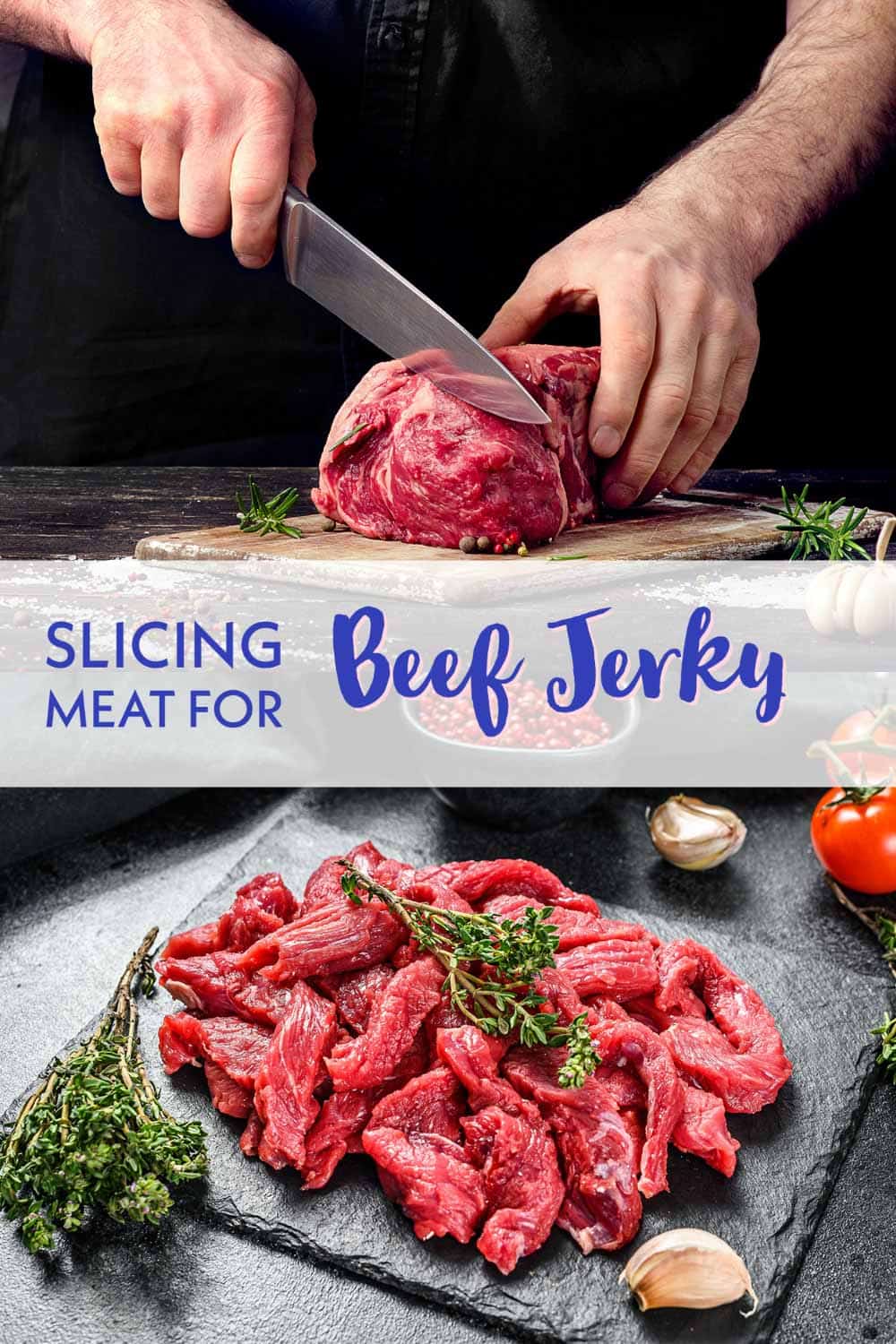


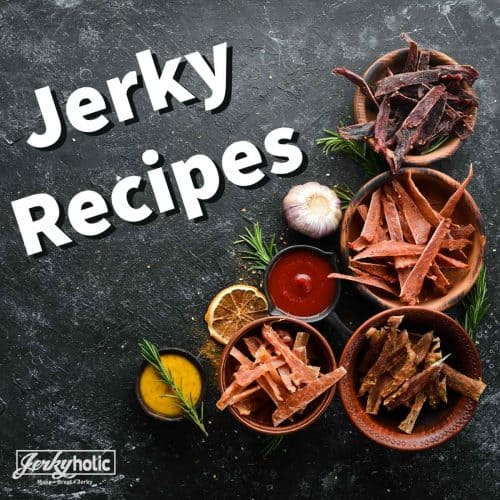
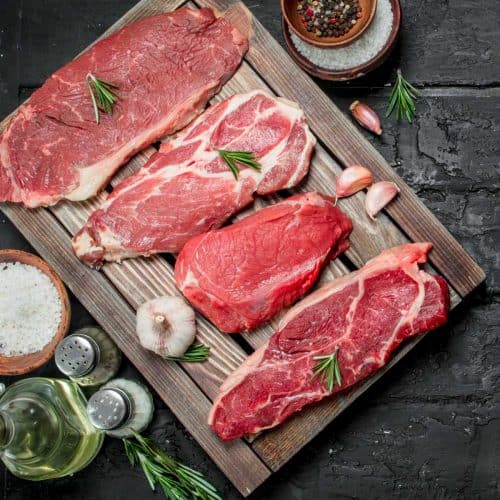
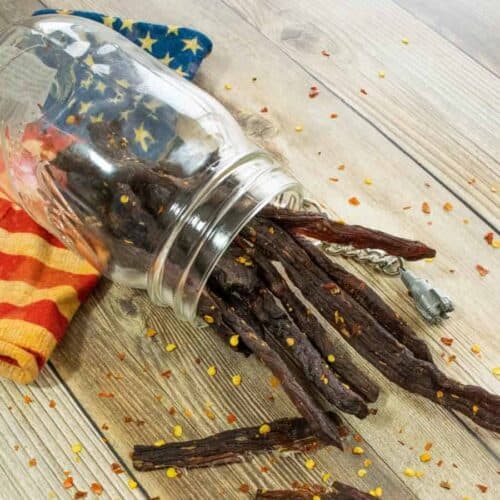
Charles Harbert says
I use a small vacuum tumbler to marinate eye of round. One hour does the trick. The vacuum tumbler can do up to 8 lbs at a time. I cut the meat across grain into 1-1/8" thick slabs then run those thru a Weston slicer (strips end up 1-1/8" wide and 1/4" thick). I use both a Camp Chef Woodwind Pro 24 pellet smoker and a NESCO FD-1010 dehydrator. I hang the meat and smoke for one hour (heavy smoke setting, 160 degrees) then finish in the dehydrator at 145 until done. I've used numerous recipes from your site. Keep up the good work!
Will says
Those vacuum tumblers work great. Definitely like the smoker / dehydrator combo, gives a great smoke flavor and perfect texture. Thanks for leaving a comment!
Stanton Dawson says
I have made maybe 6 batches of jerky so far and tilapia is one of the best I made. Haven't found anyone selling venison for a good price but love deer jerky. Does it matter what type of dehydrater I used? Or can I used any that works? Also I am hoping to try new recipes soon, amd thanks for this website it is very informational.
Will says
Fish jerky is very good. I love a good salmon jerky. Check out my page on dehydrators. You definitely want to get a good dehydrator (not necessarily expensive) to make sure the meat is reaching a safe internal temperature.
Debbie Donovan says
Hi, Will so glad this blog is still active! My name is Debbie and I'm confused. I bought some top and bottom round roasts to make jerky but after reading all this I want to know if you can have a jerky that's chewy, not leather,and tender as being older my teeth are not the best, LOL. So which way is better to cut these against or with? Or is it just not possible to get chewy and tender at the same time? Appreciate any insight, you can give, the butchers around here have different advice. Thanks so much, Debbie
Will says
Hey Debbie! Slicing against the grain will still be chewy, it will just be MORE tender than slicing with the grain of the meat. Slice your top and bottom round against the grain.
Valerie says
Anyone have suggestions on how to prep beef tongue for jerky? Parboil? And peel the skin? Slicing?
Ron says
Hi Will / All,
I'm with Brandy on the appeal of chewing jerky for "30 minutes". As a young man from backwoods northern Michigan that's the kind of jerky I remember and enjoy. Just nothing like chewing on that meat and savoring the flavor for 5-10 minutes or so, it's just damn relaxing somehow and thought provoking
We normally made our own brine concoctions with a molasses and brown sugar base then spices and beer or whatever else your taste buds might desire. It's all trial & error a "Dr. Frankenstein" method to the brine but I could never get it chewy and leathery like, like I used to purchase in the stores back in the 70s.
I am now in California using a pellet grill I just made my first batch on the pellet grill over the holiday weekend, it turned out some amazing jerky, better jerky than my Mastercraft smoker has, which can be a bit of a hassle operating.
The pellet grill jerky was pretty chewy, but not the shoe leather chewy stuff. After reading your article & advice I am going for the (flank steak) next time and a "with the grain" cut, I am pretty sure I always cut with the grain anyway, but now, I will be sure to each time!!! I have seen similar advice here on the web but your article is very well done... Will. I am looking forward to reading more from you! Thanks...Will
Happy Smoking
-Ron
Will says
Thanks for checking out the site Ron! Good luck with that flank with the grain. your teeth must be better than mine! lol
Frank says
Same here, I still make it both, or,I should say all 3 ways. I go with, against, and at an angle. The stuff with the grain is nice on hiking and camping trips if you make a smoke and pepper. In a simple form like this we add it to stews we cook in the Dutch oven.
Brandy says
Thank you for your informative articles!
I'm a HUGE jerky fanatic, but I'm getting tired of spending about $175/monthly
on it. I used to make beef jerky back in the day with a dehydrator, but it was just too tender. I recently bought another dehydrator and am ready to try it again here in a couple of days.
So, I'm trying to get the toughest, leathery-like beef jerky possible, you know the kind you have to gnaw on for 30 minutes before you can finally swallow it, lol.
My question is, I understand cutting with the grain of meat, but I'm having a hard time figuring out exactly what cut of meat to use?
Any additional info would be greatly appreciated!!
Thank you so much!
Will says
Haha. Brandy, I have had this website a long time and have had thousands of comments and you are the first that has asked how to make such a tough jerky. The question is usually the opposite! I never advise people to use a certain type of meat sliced with the grain because it's borderline inedible. However, that sounds like that's what you want. So, try buying a flank steak and slicing with the grain. Start with just one steak to see if that is really how tough you want it. That should accomplish your chewing for 30 minutes request. Make sure to come back and let me know how it turned out!
Brandon Rivera says
I have been smoking jerky for 5 months now. I love your website and all the information you have posted. Recently started selling jerky to coworkers. Just bought a meat slicer today and 28lbs of eye of round from Sams Club. Thank you SOOOO much for all of the info and recipes you have provided. Your recipes are amazing and the knowledge I have learned from this page is priceless. Thank y’all so much. Much love and respect from the woods of Southeast Texas.
Will says
Thank you so much Brandon, that really means a lot to me. The reason I started this website is for exactly this reason. Big congrats as well on pretty much starting your own jerky business! Sam's Club is pretty much the best place to buy those eye of rounds too. Keep it up!
Robert Wayne Weatherall says
Excellent reading I need a little bit of jerky in the past improving every batch since I’ve started your reading has give me a lot more information in a short time like I say knowledge in reading Have a good day WW
Audrey L Westerman says
My daughter has autism & adhd, and wouldn't eat meat of any kind until I gave her some jerky @ age 5. I've been making it for her ever since then - she's now 17. Her favorite is venison BBQ Teriyaki. Slicing it against the grain got her through her years of wearing braces, just like you said.
I hope this helps someone else who may be as desperate as I felt when my daughter wouldn't eat any protein.
Will says
Thanks for sharing, I hope that helps someone in a similar situation. I appreciate you stopping by the site and leaving a comment!
Thomas Lanan says
I think my jerky is done, but I always have some meat that I have to spit out after chewy a piece. What have I done wrong that this happens ?
Will says
Why do you have to spit out the meat? Is it too tough?
Tony Baloney says
Going to slice up my eye of round roast here soon and get it brining/curing. Thinking slice some with and some against the grain to see what I like...this is my first time making jerky, visiting this site has given me more confidence! P.s. I like your choice in pellet cooker, will be smoking my jerky on an rt-700.
Will says
Definitely try different ways of slicing. Just have fun with it. Definitely remember to take a piece off the smoker and let it cool for about 5 minutes before testing to see if it's finished smoking. If you pull it straight off the smoker and test, it will still feel soft and unfinished. Because of this you will keep smoking and ultimately over smoke it. Good job choosing the 700! I love my 590, great for jerky, chicken, ribs, prime rib....
Paul says
I'm new to making Jerky so this site and comments is just what I need.
Many thanks.
Erik says
When it comes to dehydrating the meat (using Cabela's Harvest Pro 5-Tier), I've been dehydrating at 160 for 3 hours and it gets close to done, chewy and soft, but it gets rather tough to chew after about a week or so. Occasionally I'll go as long as 3.5 hours, but that is almost brittle. 4 hours is definitely too long.
Still trying to find that sweet spot, but not sure if I'm going too high and should do lower for longer.
Any advice would be great.
Will says
Hey Erik! Once the jerky reaches an internal temperature of 160F, you can turn the temperature of the dehydrator down to 145F and finish it off. I have not used that dehydrator and am not sure how long it takes to heat the meat to 160F. Also, the meat will get more touch and drier the longer you store it. I like to make small batches and eat them quickly or use a vacuum sealer when packaging to keep it fresh.
Mark Maki says
Hey Will, thanks for ALL the GREAT information on making beef jerky! You've saved us countless hours and bundles of money experimenting by reading your pages. We've tried a couple recipes and both were fantastic. On our third batch today and your recommendation of the Weston Jerky Slicer made it a breeze - it's the 'sliced bread' of making jerky! Keep up the good work and all the best to you!
Will says
I'm glad I was able to help Mark. That slicer is definitely a great piece of jerky equipment!
Katherine FAST says
Would grass fed beef be similar to deer meat?
Will says
Grass fed beef is not going to have the same taste as deer nor be as lean. Deer is going to have a little more of a game taste because they eat other stuff than just grass. Any recipe made deer on the site can be used for beef as well. So don't let a deer recipe stop you from making it with beef!
John says
Love your site. I've been doing jerky in the oven on skewers for years and just got a pellet smoker so was looking for some tips on how to do jerky in it. Found your site and got great tips, thanks. Something you might want to try, take your leftover spiral sliced ham from Christmas dinner and make jerky. It's already sliced to a uniform thickness and doesn't need any marinade or other seasonings. Just pull off the fat from between the muscle groups and smoke it with hickory pellets/chips in your smoker. Mine turned out so good I'm thinking about doing it again with the whole ham.
Will says
That is great advice John! I will have to give it a try. I am in the market for a pellet smoker as well... Can't wait!
Wes says
Saw your article on making jerky in a smoker.
Going to try it (have always used a dehydrator). I have a rum flavored beef jerky recipe I'm going to try.
Any recommendation on what wood to use?
Will says
I always like using hickory or apple wood, can't go wrong! Let me know how it turns out!
Chuck Hickl says
Maybe this tip has been shared as I did not have the time to read through all of the comments but I typically half freeze the cut of meat I am using for beef jerky which allows me to slice it thinner and more consistently.
Lisa White says
Can you make chicken jerky? Wanting to make healthy dog treats for training.
Will says
You can make chicken jerky. I would recommend pre-heating the meat to 165F in the oven before drying to make sure any bacteria is killed. I talk about jerky safety here, check it out.
Art Gnuvo says
Sorry if this is a dumb question but is there any reason not to just have the butcher use the meat slicer to slice the eye of round when purchasing it?
Will says
Not a dumb question at all Art. You can totally ask your butcher to slice the meat for you. Sometimes they will, sometimes they won't... It really just depends on your butcher. You also can sometimes find meat that is labeled "milanesa" which is normally a top round sliced very thin for Mexican dishes. I find this every once in a while already sliced in the 'meat cooler' of my super market.
Joanne Brill says
I bought my son a smoker and it came with a 4 tiered rack. I borrowed it and made jerky and it fit perfect in my oven after I took 1 rack out. My oven only goes down to 170 so your tip about putting the wooden spoon in was a great tip. thankyou
Tony says
Great site Will . I have a 2.5 pound round of eye in the freezer gonna smoke it on my traegar this weekend. Should I cut it frozen, slightly thawed or room temp?
Will says
I would put them in the fridge until they thaw out. Then place it in the freezer for 2 hours to slightly firm up the meat, then slice. You don't want it frozen, just firm so slicing is a little easier.
Michael says
A good way to make jerky is if you have an air fryer, I do it at 180 for 1 hour each side, the problem is I can only do 3 or 4 pieces at a time so I'm getting ready to buy an air fryer oven because it will hold much more..
Foss says
Appreciate the information.
Duane407 says
We are trying a comb recipe on a batch of jerky this weekend. HOT and sweet. I'll let you know how it turns out.
Jackie says
When I over dry it it becomes crispy. I like it that way. My last batch I did about 1/2 in thick. I tend to do thinner slices. I hand slice almost shave it going to do another batch this weekend.
Richard says
I’ve been making jerky out of pork loin for 4 yrs now. I slice it while it’s mostly frozen into circles, trim any fat off ( I find it very easy this way ) then cut each piece into 3 pieces. Mix my “Backwoods “ marinade and marinade over night in icebox. I use a “Masterbilt “ 40 in smoker filled with Hickory chips, set temp to 215 for 1 hr then set temp to 175 for 6-7 hrs. IMHO it makes great jerky. I’ve just started making beef jerky this way too. I’ve found that beef doesn’t take as long to make. Enjoy your sites, I think they’re great. Full of info I can use. Thanks.
Will says
Glad you are liking the site Richard!
Aaron says
I make my jerky with a xl masterbuilt, it's soooo good, smoking adds great flavor and texture is perfect. I use cure for how long it takes. I hang the jerky on the racks after skewering it so it hangs through. This allows all the moisture to drop instead of staying on the upper side if you lay it flat. It allows it to get nice and crisp but still chewy. I also partially freeze the meat before slicing a few hrs so it's firm, that makes hand slicing easier.
Dave says
Glad I found this site!. Been making amazing jerky for years and used bottom round, sliced at the store. Mine has been cut with grain, chewy, hickory smoke and peppercorn. Flavor lasts a long time in mouth.
Going to try Eye o round against grain and a mesquite smoke flavor or a sweet sticky tender teriyaki.
I just got a slicer and my jerky world just got bigger! Great info! Thanks.
Will says
Sounds like you already are pumping out some good jerky! If you have a slicer, I know you're serious about jerky! ha.
David Wrigley says
Cool helpful
Jenifer Moore says
Hi Will, Your website is awesome! Often I end up eating jerky for a meal at work which can get exspensive with store bought jerky so I am going for broke with all your advice. I have 1 question: tho it will take longer to dry I suppose, I LOVE thick jerky and was thinking a Costco tenderloin cut in 1/2" thick strips rather than 1/4 or 1/8. Ever tried that thickness? Any additional advice? Hoping this isn't a jerky sacrilege!
Will says
Glad you are enjoying the site Jenifer! You can totally do 1/2" thick strips, and yes it will take longer to dry. Tenderloin tends to be a pretty lean meat and should be good for jerky. Normally it is not used because it is expensive and jerky is made out of "cheap" cuts of meat. But go for it! Let me know how it turns out...
Jenifer says
I took your advice and went with the Top Round (much cheaper) did a small batch and OMG its good but I I did your Post Treatment in the oven after and THAT made it PERFECT. You know you stuff Will. Thank you! I didn’t know how to add a picture here but put it on one of you Pinterest pins- they’re beautiful!
jack pretts says
Will,
You really do not want to know how the commercial store bags at 1.5 oz are made.
Most is made by grinding and they use high pressure compression to give it a chew. Worked in the business for a while.
What you are sharing on this blog is awesome. I have 17 lbs of eor chilling for slicing. Going to be a busy weekend.
Jack
Will says
Oh man, thanks for the insider info. Yeah, I'll stick with my own jerky. Ha. Let me know how your jerky turns out!
Mac McAtee says
Jerry, new to your blog. Thank you for doing this.
Got a question about slicing. What if you took your eye of round, cut it across the grain in 1 1/4" thick cuts. You'd end up with roughly four disks of meat. Then you take each disk and laying flat on the cutting board, slice your 1/4" strips for jerky off each disk.
That would give you 1 1/4" wide strips with the grain running across the narrow direction. It would be less tough than grain running lenght wise and more chewy that cutting slices across the grain.
Have you ever done it that way? Any comments?
Mac McAtee says
Sorry, I meant to address you as Will. My bad.
Will says
It would be a little of both. I normally don't slice it like that because my strips would be very short. I do have an eye of round in the fridge that I will slice this way and get back to you though!
john says
All commercially produced jerky that you find in the store is tender. You know those producers don't take the special slicing and marinating steps that you are emphasizing, so there must be other means for tenderizing their product?
Will says
You are 100% correct John. I am trying to figure out how they get their meat so tender. If you figure it out, let me know! This is my #1 goal right now...
Rebecca says
I thought it might interest you to know that MSG is frequently used as a meat tenderiser by the food industry.
Will says
Thanks Rebecca!
robert says
Another natural way to tenderize meat is kiwi and other acidic fruits fruits. experiment with these methods and you'll be surprised how effective they are. I'm sure in commercial environments they are using some chemicals that produce the same effects. Acid breaks down the fibers in meat. I find rubbing it with kiwi and letting it sit with the juices does very well. You can even over do it so try different time amounts to get it to your liking.
Will says
Thanks Robert. I have not tried kiwi, but will experiment with acidic fruits. I appreciate the tip!
Zachary says
I actually put a little lemon juice in my marinade. I like the little kick it gives to the flavor, but find that it tenderizes my meat a great deal.
Clifford Hayes says
Try some pineapple juice in a marinade. The sweetness,acidity and flavor are good with beef jerky.
Murasame says
I’ve looked a lot into good ways to tenderize meats for cooling and I came across two that work really well: salt or pineapple pulp. You can sprinkle it before you cut it and let it sit for longer (one to two hours) or you can do after you’ve sliced it and let them work their magic for less time (15 minutes). Which ever you choose to use, make sure to thoroughly rince the meat before you apply the sauce.
Mike Schmalz says
Acid is great for jerky. It not only helps tenderize the meat, but if you want to store your jerky long term, in your marinade you can use some potassium sorbate (a common non-toxic, mostly flavorless, and inexpensive preservative) to inhibit mold and yeast growth, but you will need to make sure to use some fruit acid, vinegar, or something to lower the PH of the meat to just below 7, or else the preservative is ineffective. Too much of course will make it taste bitter. Moist jerky does not keep long, it must be desiccated as much as possible for long term storage.
lori says
https://www.bing.com/videos/search?q=how+do+they+make+jerky+&view=detail&mid=E6AE4156D3DE79B705FBE6AE4156D3DE79B705FB&FORM=VIRE
just starting to try making my own jerky..i bought a dehydrator and I am trying oven method..i will let you know how it goes!
Will says
Awesome Lori! Hope it turns out great!
Charles Wersal says
I found slicing with the grain is more popular with the commercial makers of beef jerky. I have tried both cross grain and with the grain. I think my cross grain does
get more flavor from the marinade than the with grain but I don't care for the
texture of the cross grain I have been making jerky in my oven for over 20 years.
!50 degrees for about 8 hours. I just bought a food dehydrator yesterday and am
going to try it.
Will says
Everyone has their favorite flavors and textures, it's all about finding what works for you! Let me know how the dehydrator works out for you.
Anne says
Fantastic information, love the explination about grain, I've always been a bit confused. I have an old round dryer too like a coment above. It's phamlet said to cook the meat first, which I do in but wonder now about patting it dry and then just putting on dryer. Your thoughts!
Thanks for this site, I am trying the teriyaki today and love that I have more recipe options now.
Will says
Hey Anne! I have had this question a couple times before, so I put it an answer on the FAQ Page. Check out the answer to your question there and then make sure to let me know how your jerky turned out!
Jerry says
I made jerky with bottom round. It was cut against the grain but was very tough. Did I dry it too long?. Thanks! I enjoy your website. BTW, I keep my jerky in the freezer. Jerry
Will says
Hey Jerry. I wouldn't think that it would come out too tough if it was cut against the grain. I would use eye of round (my favorite) and tenderize it with a meat mallet before marinating. This should definitely make it more tender. I am not sure if you over dried it. Just because it is tough doesn't mean it is over dried. I'm glad you like the site! Thanks for coming by and checking it out!
Jim says
I used eye of round, sliced against the grain, tenderized it with a meat mallet, cooked in a dehydrator at 145 degrees for 6 hours, and it came out very tough. Is this from cooking too long bad cut of meat or what? Thanks, enjoy your web site
Will says
You might have dried it too long. Make sure to start testing it at about the 4 hour mark. When you test it, take a piece out of the dehydrator and let it cool for 5 minutes before seeing if it is finished. Check out my page on making jerky in a dehydrator for a little more information.
Jerry says
Thanks Will. I am trying eye of round and will keep an eye on it this time. Great website. Thanks so much!
Ed says
Hello.. I've been making jerky for about six months now and find I'm making a batch every weekend. The beef I've been using is top round which I've been buying from a local butcher who slices it on a ban saw. Because they are slicing it, they charge a premium for it. I started researching electric slicers (I want the uniform thickness) and found slicers with both serrated and non-serrated blades. Can you recommend a blade type that's not going to destroy the texture of the beef? Thanks in advance.
Will says
I can not recommend one at this time. I hand cut all of my meat and do not use slicers because of so many bad reviews I've found when researching them. I might buy 2 or 3 here in the near future and do my own testing on them, but have not used one as of yet. Sorry I couldn't help. If you get one, let me know which one and how well it works!
Mike says
My 14 year old is in braces and very much enjoyed my beef tenderloin jerky I made last weekend. Beef tenderloin is a bit pricey for jerky meat, however. I cut that by hand along the grain, but I am doing eye of round this week on my 1940's vintage Hobart Model 410 "streamliner" deli slicer (BTW - most useful countertop appliance in my kitchen)
Going to try slightly frozen and cut across the grain to see if I can make braces-friendly jerky on a budget.
Will says
1940's?! I bet that is one very well built slicer! (a little jealous over here...) Let me know how it turns out Mike!
Gary Guagenti says
What a great place for Jerky Lovers! Thanks so much for your advice. I have just learned more about making jerky in 5 minutes than I learned in a lifetime!
Will says
I appreciate that Gary! That is the reason I made this site. I'm glad I could help!
Philippe says
Hi Will, and thanks for the great info on your site. I am a bit concerned that slicing eye of road against the fiber might produce very large slices. If I start slicing against the grain to keep the cut tender, will I ruin the effort by cutting the slices into strips? I guess cutting slices into strips comes down to doing the last cut with the grain.
Any advice on how to manage create tender strip in regard to sequence of cutting?
Will says
If you slice against the grain and get a very large piece, slicing that large piece in a strip will NOT ruin the effort of making it less tender. You will notice that when you go to slice a "large slice that was cut against the grain" into a strip, with the normal shape of a eye of round, you will not be cutting with the grain but simply only cutting that slice into smaller strips. Once you cut a slice against the grain, the grain now runs lengthwise ONLY as thick as your slice was cut, normally 1/4". With the grain in a piece only running 1/4", it will not be chewy no matter how you slice it into strips. This was extremely hard to describe! Once you go to cutting your slices, it will all make sense... Thanks for the question Philippe!
D says
I love the big pieces......after drying I use kitchen shears to cut into strips. Works great!
Roger Williams says
Will thanks for making me crave jerky .. Walking out the door to go too Walmart and buy a dehydrator, meat ,and all the ingredients to make damn jerky this weekend ...
Will says
Nice! Let me know how it turns out!
Vince says
Tried my first batch of chicken strips. Heat too high at 225. Ready to try beef. Going to lower temp to 165. Thanks for the tips!
Tania says
Great info. I've never made jerky before, and I want to try this weekend. I don't have a dehydrator, so I'm going to do a small batch, slow cooked in the oven. wish me luck.
Mike Taylor says
Thanks for the great post. So you are saying cutting WITH the grain and tenderizing will lead to more tender jerky than cutting against the grain.
Will says
Thanks Mike! No, it will give you a chew that is in between only slicing with the grain and only slicing against the grain.
Laurie says
"The grain" is like a piece of wood...if you want to make a Tough Board, you saw along the grain. If you want a weak board, you saw ... Against the grain. As if you are cutting down a tree. Pretty much like that.
Foss says
Other way around
John Blando says
Thanks for the info..against the grain makes the most sense..I'm new to making jerky and i have an old round dehydrator..I'm still experimenting..different marinades and cuts of beef..I feel bad though..just ruined a two pound piece of tip by leaving ot in too long..live and learn huh?
Will says
Welcome to the world of making jerky! It's going to take some time and a couple pounds of over dried jerky to get it dialed in perfect. Have fun!
Rebecca in Portland says
I wonder if you have "over dried" jerky if you could crush it into bits (like bacon bits) and sprinkle it on salads or potatoes?
Will says
You could totally do that. It might be a little chewy, but could taste great!
Dan Krug says
Hey! Rig recipe has great flavor! The problem is that it came out super chewy. Had it cut into 1/4 inch strips with the grain and had it running about 5.5 hrs in the Nesco that you recommended. I'm wondering if it is the grain cut coupled with it maybe being left in too long? Any way I can get it less chewy?
Will says
Slicing with the grain will definitely make it a more chewy jerky, but also start checking the jerky to see if it is finished after about 3.5 - 4 hours. 5.5 hours might have been too long. There isn't really anything you can do to the jerky now to make it less chewy.
Tia says
Pound it and mix with dried fruit and seeds or nuts
CurtTheJerkyGuy says
Rebecca I have used jerky in salads and on potatoes and in soup and burritos and tacos. Cowboys would heat water and add jerky for a meaty meal. And the dried out does chop up nicely. Making jerky over 30 years. #MasterbuiltSmokerOnly
TONY says
Saw a recipe that adds jerky to hamburger patties, add to the raw hamburger and cook! Adds a great flavor.
Chelsea Smith-Nelson says
another great application is sprinkled into instant ramen when backpacking. It will reconstitute and taste great while adding lovely meat flavor to the broth. Just be wary of salt!
Judi says
Grind the jerky and add cream cheese, scallions. Great dip
Tosha says
This sounds delicous
Trudy Dunkin says
Put a piece of bread in the bag or container with the jerky and it will soften it up. I have had to do this and it works great.
Jason says
I did a few pounds of Jerky in my old round dehydrator and it was quite brittle due to being left in the dehydrator about 3 hours too long...YIKES! But - I managed to re-hydrate it and it was exceptional.
I took a large glass baking dish (deep is good here) and put a 1 cup glass bowl right in the middle. I then put all the jerky in the dish around the bowl. I piled it in but used a deep enough baking dish that it all fit. Then I poured boiling hot water in to the 1 cup bowl. Threw some cling wrap over it - nice and tight - then left it on the counter for the day while I went to work. I got home after work and took the cling wrap off - it was incredible - the jerky sucked up all that wonderful steamy moisture and it was perfect. I was more than impressed! Good luck fellow jerky fanatics!
Jeff says
I've over dried jerky on occasion. Easy fix = slice a small celery stick lengthways, and half a carrot. Chuck in a ziplock bag with the over-dried jerky, shake it and leave it in the fridge overnight. The jerky will rehydrate and draw in some of the veg flavour. You could use anything else but I like the added flavour from this method.